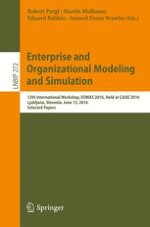2016 | Book
Enterprise and Organizational Modeling and Simulation
12th International Workshop, EOMAS 2016, Held at CAiSE 2016, Ljubljana, Slovenia, June 13, 2016, Selected Papers
Editors: Robert Pergl, Martin Molhanec, Eduard Babkin, Samuel Fosso Wamba
Publisher: Springer International Publishing
Book Series : Lecture Notes in Business Information Processing
